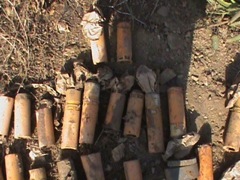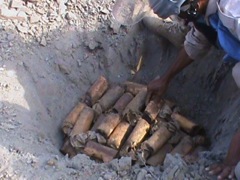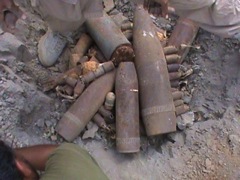By Mark Hiznay, Senior Researcher — Arms Division, Human Rights Watch
While editing Cluster Munition Monitor during the summer of 2013, I received a set of photographs showing numerous unexploded submunitions in the Sa’adah Governorate of northern Yemen, near the border with Saudi Arabia. This was the first visual confirmation of a rumor about cluster bomb use that had been circulating for a few years.

Unexploded BLU-97 submunitions present in a district of Sa’adah Governorate near the border of Yemen and Saudi Arabia in July 2013. Photo courtesy of the Executive Committee Office of the Houthi Administration.
The Government of Yemen fought an armed insurgency in the region by Houthi rebels from 2004 to 2010 – today the Houthi Administration claims control over the Sa’adah Governate. Fighting flared in August 2009 and intensified as fighting spilled over the border in November and Saudi forces conducted airstrikes and intervened on the ground.

Unexploded BLU-97 submunitions collected for demolition in July 2013. Photo courtesy of the Executive Committee Office of the Houthi Administration.
Remnants of at least two types of cluster munitions are shown in the photographs:
• air-delivered BLU-97 bomblets, and
• surface-fired dual purpose improved conventional munitions (DPICM) submunitions.
With two different delivery methods implied — one dropped by an aircraft and the other fired from a large artillery piece or rocket – it would seem to have been beyond the military capabilities of the Houthi rebels to use these cluster munitions.
Yemen is thought to stockpile only cluster munitions of Soviet origin. These BLU-97 submunitions are of US-design. US export records show that Saudi Arabia has received significant exports of air-dropped bombs containing BLU-97 submunitions from the United States. Although the exact type of DPICM submunition is unclear, it was surprising to me to see them since it indicates cluster munition use by ground forces at perhaps a much larger scale than initially rumored.

Numerous DPICM submunitions are among several types of dud surface-fired ordnance photographed in a district of Sa’adah Governorate near the border of Yemen and Saudi Arabia in July 2013. Photo courtesy of the Executive Committee Office of the Houthi Administration.
It is not possible at this time to determine responsibility for the use of these cluster munitions. The photos provided by the Executive Committee Office of the Houthi Administration provide some intriguing indicators, which only lead to more questions.
However one thing is clear – there is a need to survey the degree of contamination, warn and educate the population about the risks posed, clear the unexploded ordnance, and assist any victims.
It is important to note, but not confuse, this circumstance in Sa’adah Governorate with the use by the United States of cruise missiles armed with warheads containing BLU-97 submunitions in an attack on the hamlet of al-Majalah in southern Abyan province, also in December 2009, as documented by Amnesty International and Human Rights Watch.
